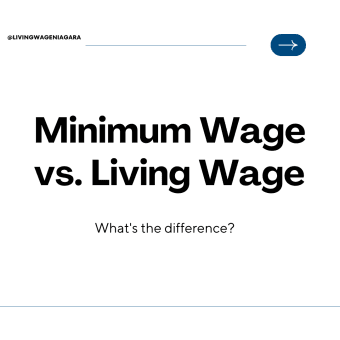One of the most frequently asked questions about the living wage is “How is a living wage any different from the minimum wage”? It’s a fair question, considering most businesses abide by the federal or provincial minimum wage standards. Below is a quick primer on five ways the living wage differs from the minimum wage.

In Ontario, the living wage is determined regionally. In 2022, the Ontario Living Wage Network (OLWN) divided Ontario into 10 regions, each with its own living wage based on the cost of living in that region. In Canada, and globally, living wage organizations take factors like food costs, local housing prices, and transit availability into consideration when calculating the living wage for a region. By contrast, the minimum wage is much broader, applying provincially or federally, and does not take region-specific factors into consideration. As such, the minimum wage may not be enough to maintain a healthy, comfortable lifestyle in some regions.
In October of 2023, for example, the minimum wage in Ontario will be raised to $16.55/hour. This may provide a fine standard of living for regions where amenities are less expensive, but for populous regions like Toronto, Hamilton, or Niagara, the minimum wage may lag behind the ever-increasing cost of living.
2. A living wage is not a legal requirement
Unlike the federally and provincially mandated minimum wages, businesses are not required to adhere to the regional living wage. Instead, employers can voluntarily agree to provide their employees with a living wage and become living wage certified by contacting Living Wage Niagara or the OLWN. Providing a living wage is seen as an optional long-term economic investment by business owners who recognize the value of improving their employees’ standard of living through higher pay.
3. A living wage changes annually
While recent increases in minimum wage have been tied to increased inflation or the consumer price index, there have been times where the minimum wage has not increased on an annual basis. On the other hand, the living wage calculation is performed annually, and considers price increases on commodities as well as financial inflation across the board. As such, the recommended living wage for a region generally increases year over year to keep pace with inflation and ensure workers are able to maintain a basic standard of living. Although unlikely, should the cost of living in a region decrease, the living wage recommendation may also follow suit.
4. A living wage is not a price floor
One criticism of minimum wage is that it sets a price floor, allowing employers to underpay workers by legally compensating them with the minimum allowable rate. Instead, the living wage provides a guideline indicating the hourly pay workers need to earn to maintain a basic standard of living. Although living-wage certified employers agree to provide wages starting at or in excess of the calculated amount, it is not considered a binding minimum. Employers are instead encouraged to value their employees’ labour accordingly, while ensuring they do not fall below the carefully calculated standard of living.
5. A living wage takes families into consideration
Part of the annual living wage calculation involves determining the cost of living for both single individuals and families. There are three distinct family groups whose annual costs are factored into this equation: 1) two parents with two children, 2) one parent with one child, and 3) one single adult. These three data points are averaged out to determine the necessary living wage for a particular region. This way, it can be better determined how much money is needed to keep families and children out of poverty.
According to the 2021 census, approximately 8.5% of youth under 18 in Canada live in poverty, and while these numbers have been trending downward, youth typically have little means of bettering their circumstances on their own. These rates also tend to increase in single parent families. In Niagara, 25.8% of single parent families are considered low income, meaning they survive on a single income that does not provide a living wage. A living wage is a crucial tool to help alleviate the financial stress on these families caused by low wages. The minimum wage in Ontario is not typically calculated with these factors in mind, and is generally based upon the annual consumer price index.
Everyone deserves to be able to live their lives free from hunger or homelessness, and a living wage can truly make a difference for everyone. The benefits are both personal and public, as the living wage has economic benefits throughout the community. This includes higher worker retention and more money to be spent in local communities. For more information on becoming a living wage certified employer, check out our page on becoming a certified living wage provider here.

